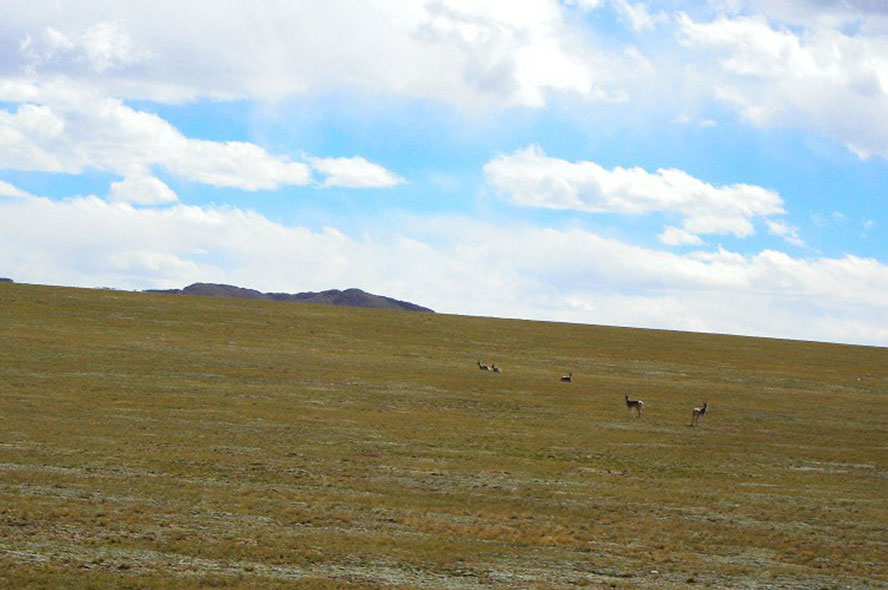Even though it will take long time to get to Tibet from places outside Tibet by trains, taking trains to Tibet is still very popular among tourists. Xining is the nearest city to Tibet along the Qinghai-Tibet Railway, yet it still needs 22 hours to get to Lhasa by trains. Therefore, what to eat on the trains has become a concern for tourists. This article will give you a detailed introduction to the questions related to what and where to eat on the Qinghai-Tibet trains, especially the question related to the dining carriage on the trains.
Having meals in the dining carriage
Introduction to the dining carriage
A dining carriage is generally located in the middle of a train. It is also the carriage which separates the hard sleeper carriages and soft sleeper carriages. There is only one dining carriage and it holds the only kitchen and restaurant on the train.
The decoration of the dining carriage is featuring with Tibetan characteristics, with red, yellow and white as major colors, which are also major colors of the Potala Palace. The windows in the dining carriage are broader and are more suitable for enjoying scenery.
There are a great number of passengers on the train, so the amount of people in the dining carriage during dining time is also very large. Therefore, tourists who plan to have meals in the dining carriage must reserve a table in advance so that they don’t have to wait for a long time.
Menus in the dining carriage
Breakfast, lunch and dinner are all available in the dining carriage. All the meals are Chinese-style. Traditional Chinese breakfast such as steamed buns, steamed buns, soy milk, pickles, and porridge is available in the morning. Sichuan-style stir-fried dishes such as scrambled eggs with tomato are for lunch and dinner. The dishes are not semi-finished food but are cooked on the trains. All of the ingredients are purchased in large and medium-sized cities, and there will be replenishment points at corresponding stations. The ingredients on the trains may change as the seasons change, but common ingredients usually include potatoes, green peppers, tomatoes, cucumbers, chicken, and pork, etc.
There are two options for passengers to order dishes in the dining carriage. One is the set meal. A set meal may include four dishes and one soup, or five dishes and one soup, etc. Therefore, the prices of different set meal are different. Passengers can choose a set meal in accordance to their own needs. The other is the à la carte. It refers to a practice of ordering individual dishes from a menu, which is convenient for passengers to eat alone or for two passengers.
Meal supply time in the dining carriage
Meal supply time in the dining carriage is from 7:00 am to 9:00 pm, and the time may be adjusted accordingly. If you want to enjoy the scenery from the windows during your dining time, you should have meals in the daytime. Although there is no limit on time for dining, in order to meet the dining needs of other passengers, you are not recommended to eat very slowly, and you shouldn’t stay too long in the dining carriage.
Having BYO food (bring-your-own food) for meals
There are hundreds of passengers on a train, yet the dining carriage can only accommodate around 30 people. Therefore, it is impossible that every person can have meals in the dining carriage in one time. Besides, the prices of the food on the trains are relatively higher, so a lot of passengers will choose to bring their own food to the trains. For passengers in sleeper carriages, their train journey can be more comfortable if they bring the food they like to the trains.
Food that can be brought to the trains
Generally speaking, most of the food such as cooked foods, fruit, snacks, and drinks can be brought to the trains. As many people will live together in the small space of the trains for more than 20 hours, food with pungent smell such as durian is not recommended to bring to the trains. Besides, alcohol-containing drinks cannot be taken to the trains because they are flammable.
The temperature and environment in the trains are unfavorable for keeping food. Therefore, even though cooked foods are not prohibited, passengers are still not suggested to bring them to the trains, because they are easy to decay and can’t be kept for a long time. And the food that will easily get rotten or the food that wouldn’t be eaten immediately is also not suggested to be brought to the trains, either.
You will see an interesting phenomenon while taking the Qinghai-Tibet trains: The plastic bags that pack snacks like bread will swell when the trains are running through high-altitude areas. This is because air pressure will also change when altitude increases. And external air pressure changes are also the cause of altitude sickness.
The food that passengers often bring on the trains includes: barreled instant noodles, self-heating bento, canned snacks, beef jerky, chocolate, bread and other food that can satisfy hunger. Besides, melon seeds, peanuts, and dried fruit are also popular snacks when passengers are chatting on the trains.
Where to eat BYO food?
You can directly eat your own food in your hard seat carriage or sleeper compartment. Hot water is provided on the trains, so if you need to brew your instant noodles, coffee, or milk tea, just bring your own cup to get the water from the water dispensers.
The table in each soft sleeper compartment is not only a place to put objects, but is also a small dining table. If you need a place to eat snacks such as bread, your bunk will be a good choice.
There is also a table in each hard sleeper compartment and there are also tables in the corridors of each hard sleeper carriage. As for the hard seat carriages, there is a table between two face-to-face rows of seats. All of these tables can not only be used to put things but can also be used as a dining table. Besides, in order to reduce the smell of food in the carriages or compartments, some passengers will choose to bring their food to other places when they need to eat the food.
Instant food on the trains
In addition to having meals in the dining carriage and eating your own food, you can also buy some instant food on the trains.
What instant food can passengers buy on the trains?
Ranking the first should definitely be the bento, which is a special food on the trains. Bento is usually made by restaurants nearby the train stations in cities. Then the bento will be packed and carried to the trains. Bento is provided during dining time. There are generally three or four kinds of bento for passengers to choose. And the prices of bento are much lower than the food ordered in the dining carriage.
The second choice is snacks and fruit. The train staff will push a food trolley from carriage to carriage, selling all kinds of snacks such as instant noodles, melon seeds, peanuts, beef jerky and mutton jerky. And there are also various of seasonal fruits on the trolley for sale.
While taking the trains, you will easily get thirsty because of the dry environment in the trains. Drinking more water and eating fruit will be helpful in relieving the discomfort cause by hydropenia (a condition in which the body is deficient in water).
Dietary recommendations on the trains
Recommendations for BYO food
1. Oranges, tangerines, and peeled grapefruit are recommended to bring to the trains, as the unique fragrance of grapefruit and the fragrance of the peels of oranges and tangerines can relieve carsickness and can refresh your mind.
2. Food such as cucumber that can be eaten raw is also suggested. But you need to wash it in advance, peel and cut it into segments, and put them in a fresh-keeping bag. Cucumber is rich in dietary fiber, which can alleviate the inflammation and constipation caused by the dry environment in the trains.
3. Tropical fruits such as mango and lychee are not suggested to bring to the trains. A train is a closed space and the environment inside is dry, so passengers are easy to get inflamed. Therefore, passengers not recommended to eat tropical fruits, which can worsen the inflammation or constipation.
Tips for dining in the dining carriage
1. Reserve a table in advance. There are a large number of passengers in the dining carriage. If you reserve a table in advance, you don’t have to wait for a table for a long time.
2. Eat more vegetarian food while you are having meals in the dining carriage. When the trains arrive at plateau areas, boiling point of water and oil will be effected by the air pressure, which will have influence on the taste of food.
3. When you go to the dining carriage for meals, do carry valuables with you and don’t leave them in the sleeper compartment.
Dining is not a problem on a train to Tibet
There is no need for passengers to worry too much about the dining problem on the trains, as there are many measures that can solve this problem: having meals in the dining carriage, eating BYO food, or buying food from the food trolley. Even though the choices of food on the trains are not as rich as those in cities, passengers can have a totally different dining experience on the trains. While they are having meals, they can also enjoy the beautiful scenery from the windows and see different kinds all animals along the way. Therefore, they will feel the food delicious no matter what they are eating.








































 Data in submission...
Data in submission...